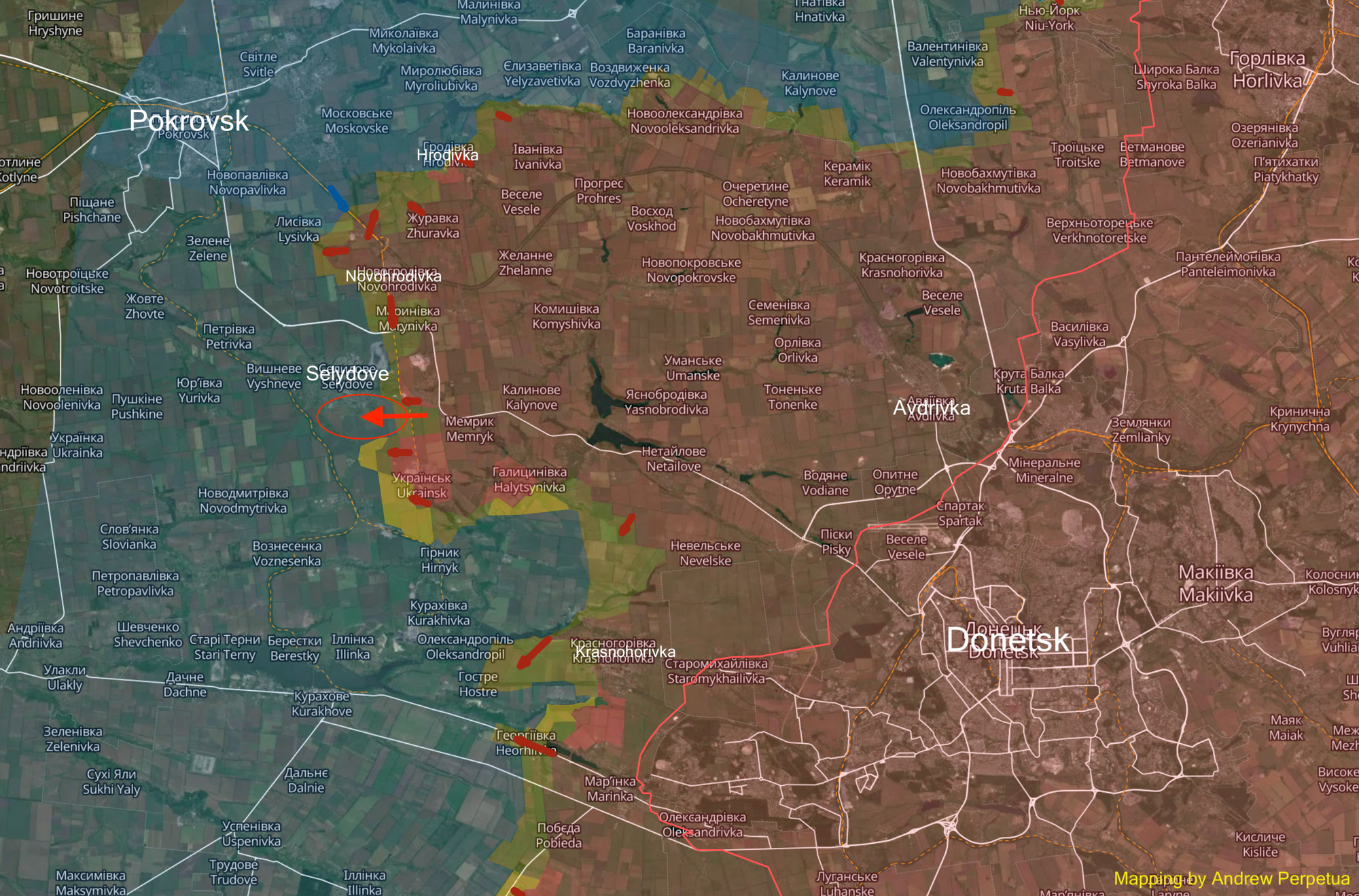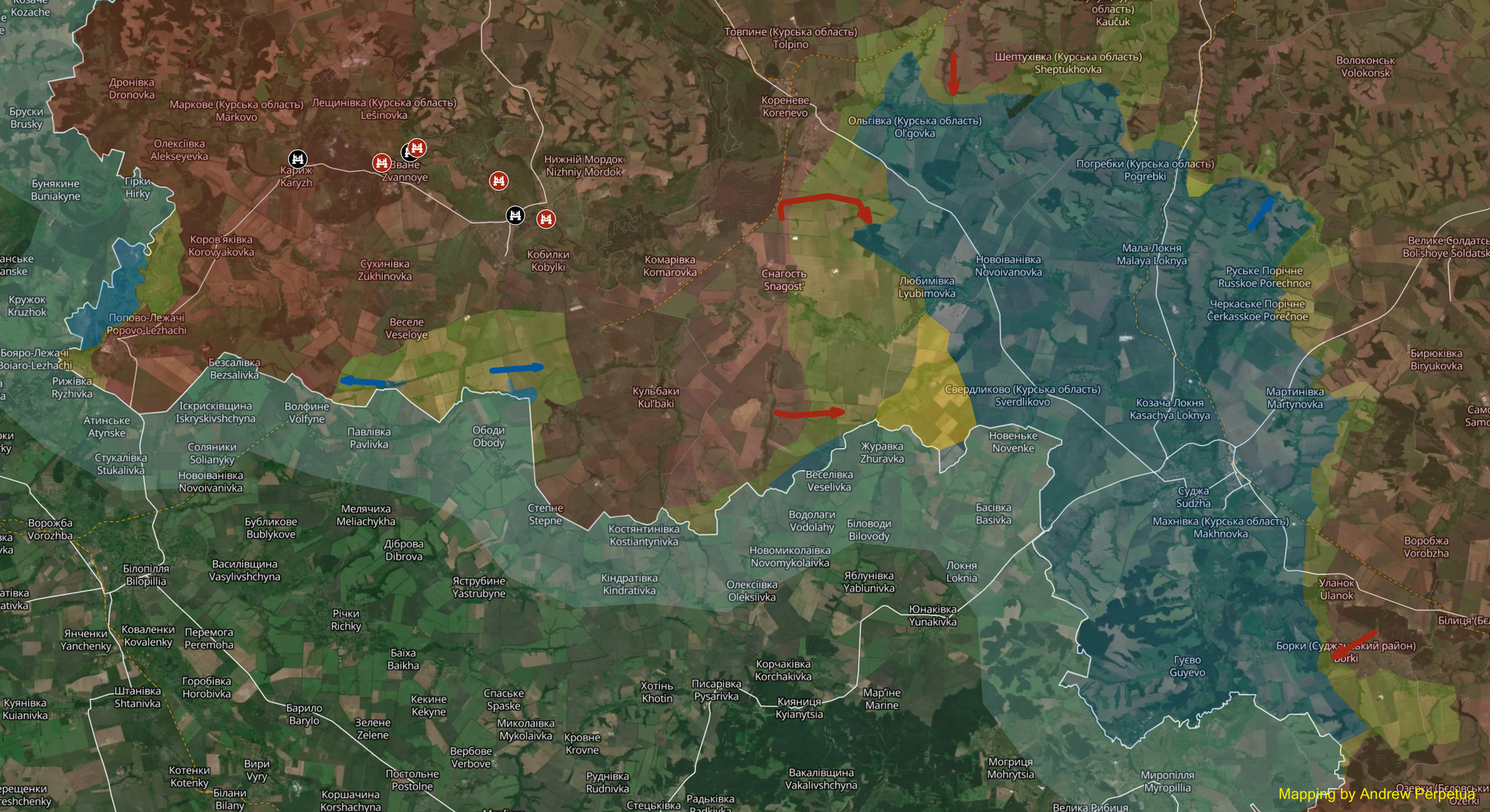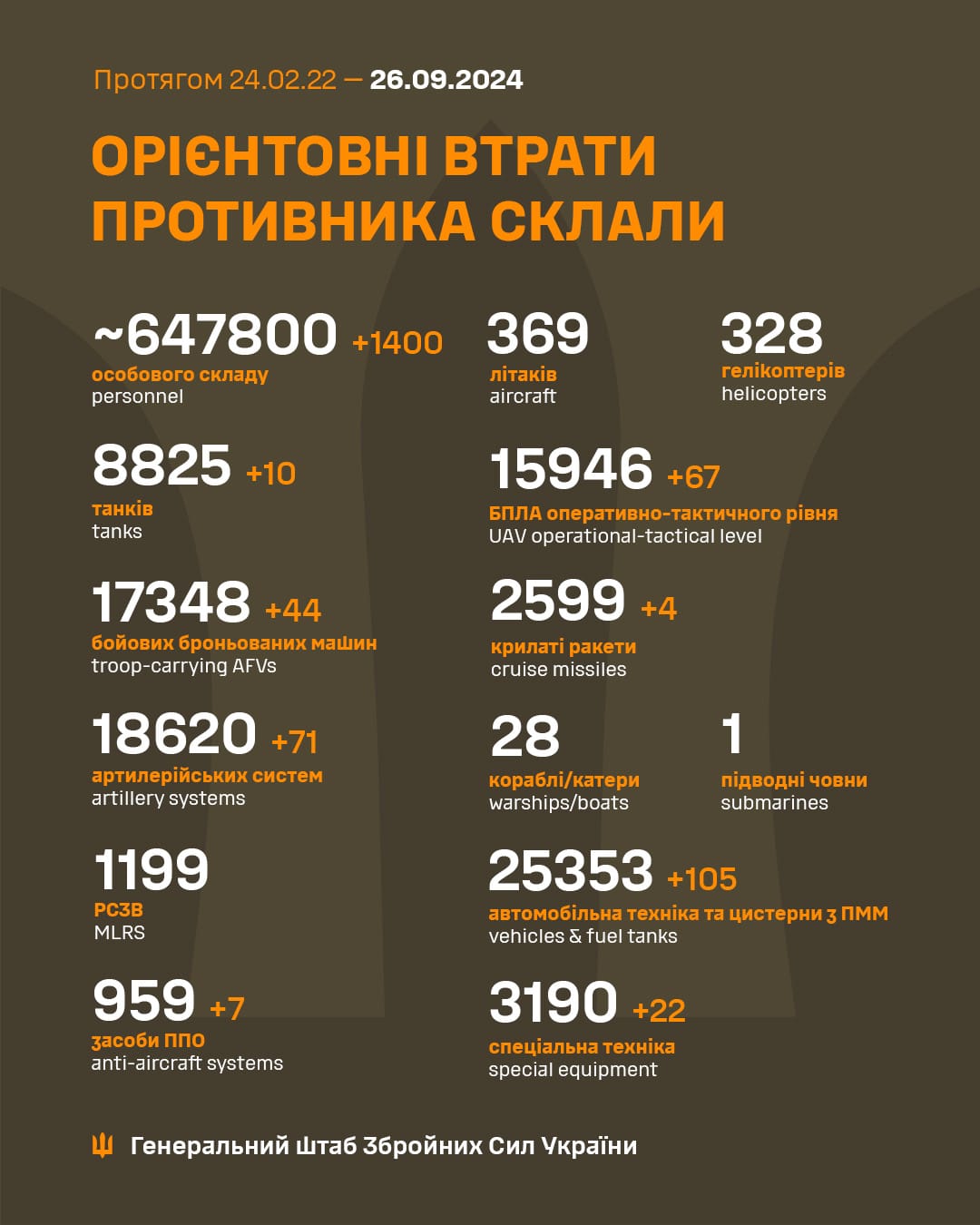Since the last update in June, it seems that a few things have happened.
Russia launched an assault toward the city of Pokrovsk that threatens Ukraine’s ability to defend a large portion of Donetsk. Ukraine crossed the border into Russia, gaining control over 1,000 square kilometers of the Kursk region. Ukrainian President Volodymyr Zelenskyy reorganized important sectors of the Ukrainian government and fought off growing political opposition. In the air and on the ground, drones continued to improve and redefine their role in this war. Ukraine triggered unbelievable explosions at ammunition storage facilities in Russia as disputes continued over Ukraine’s ability to use Western weapons deep inside Russia. Zelenskyy pissed off MAGA Republicans by visiting Pennsylvania, where 800,000 Polish Americans are deeply concerned about the possibility of Russia carrying its illegal war into NATO countries. And Donald Trump said something profoundly stupid that also happened to be about Ukraine.
Catching up on all these topics—and a dozen more—isn’t possible in a single article. So think of this more as an overview of just a few areas intended to bring things up to date so that future Ukraine Updates can do what they do best: get way, way down into the weeds of how, why, and where.
In this war, three months is a long, long time.
Is Vladimir Putin losing his grip on power?
There have been rumors in the past that Russians were growing tired of seeing hundreds of thousands of men shipped off to Ukraine, and hundreds of thousands returning with serious injuries. Or not at all. But as usual in Russia, recruitment for the illegal, unprovoked invasion of Ukraine has largely affected outlying ethnic districts, leaving the power base in Moscow and St. Petersburg only lightly affected.
Despite a few rapidly suppressed protests, talk of potential coups, and a lot of turnover in the military, Putin seems as thoroughly ensconced as ever. Even the two-day aborted coup by Yevgeny Prigozhin and his Wagner Group mercenaries appears to have left Putin unmoved — and Prigozhin won’t be trying again.
As is always the case, what’s going on within the Kremlin walls is a complete mystery, and any claim that Putin is on shaky ground is itself… shaky. Keep that in mind.
Vladimir Solovyov has been the host of multiple propaganda programs on Russia-1 for over a decade. He’s more than just a newscaster, but a media personality. Calling him the Sean Hannity or Tucker Carlson of Russia is underselling it (neither of them has two music albums… let’s hope). This guy is just everywhere in Russia.
Solovyov has been one of the voices not only championing the invasion of Ukraine, but pushing for Russia to carry the war into NATO countries. He’s also supported the harsh treatment of dissidents and recommended the firing squad for poor military leaders. Above all, Solovyov has been a cheerleader for Putin. One of the programs he hosts is even titled “Moscow. Kremlin. Putin.”
This explains why a single suggestion that bringing the invasion to a conclusion might require Putin to “resign” is getting considerable attention among Russia watchers. Kremlinology is an art that pre-dates the Cold War, and practitioners are once again training their scopes toward Moscow to see if this remark indicates some kind of change in the winds of power. That includes some statements that seem about as overblown as most of the propaganda Solovyov churns out.
So, does any of this mean Putin is in trouble? Almost certainly not.
However, as The Times of London reports, dissident Vladimir Kara-Murza, one of the men who successfully lobbied for the passage of the Magnitsky Act, says that while Putin may seem like the one eternal fixture when discussing Russia, that’s not necessarily the case.
“Political change in Russia usually happens suddenly, unexpectedly, when nobody sees it coming, and nobody is ready for it,” Kara-Murza said.
Now would be good.
Russian forces continue to advance in Donetsk Oblast
Until a few months ago, Ukraine had done an astounding job of holding back Russian forces near the occupied city of Donetsk. Even in the early days of Putin’s second Ukraine invasion, when the Russian military came pouring through areas to the north and east, Ukraine was largely able to hold Russian troops behind the lines that had been established following the 2014 invasion.
The way that Ukrainians held onto positions like those around the town of Avdiivka and Vuhledar, and the losses they inflicted on Russian forces that seemed locked in mindless efforts to advance, became legendary. However, when Russia finally captured—and utterly destroyed—Avdiivka in February, Ukraine fell back to positions that lacked the defensive infrastructure of those nearer to Donetsk. Within weeks, that single breach turned into a slow flood as Russia pushed through the former line at multiple locations.
Ukrainian forces, exhausted after months of fighting and facing Russian troops bolstered by continuing rounds of conscription, were forced to retreat along a broad front. Meanwhile, Ukrainian commanders complained of an ammunition shortage that had been exacerbated by the long delay in attaining more support from the United States. It took until April for Republican Speaker of the House Mike Johnson to stop blocking funds for Ukraine, and by then a lot of damage had been done.
Where previously Russian gains in this area had been measured in meters and Russian forces spent weeks contesting the same tiny crossroads, the pace of the Russian advance in the spring was considerably higher. It took weeks before new lines were formed near the recently captured village of Pervomaiske in April. From that position, Ukraine was able to establish a somewhat stable front that largely held through most of the summer.

But in August, Russia concentrated still more forces in the area and began a renewed push that, compared with much of their movement over the last two years, was positively explosive. Russian troops took Krasnohorivka in the first week of September. At the same time, it captured Karlivka and villages to the south. From there, Russian forces advanced kilometers each day, moving toward the cities of Pokrovsk and Selydov. A week after Krosnohoivka, Russia was in Novopokrovske and had partially occupied Hrodivka.
Since those losses, Ukrainian forces have managed to slow the Russian advance. However, Russia continues to press aggressively along this whole line. Since the fall of Avdiivka, Russia has progressed 35 kilometers toward the critical junction at Pokrovsk. Considering that took over 220 days, it's not exactly a lightning advance (an overall rate of about 15 meters a day). However, about half that distance has come in the last four weeks. Also, since the width of this advance is around 20 km, it’s more of a bulge than a salient. Any effort by Ukraine to harry the advancing Russian force along the flanks will be difficult.
Though Ukraine is now reportedly moving in additional troops following its own mobilization bill in the spring, the ability to check the Russian advance short of Pokrovks remains a serious concern. Evacuation of the city was ordered in August, but residents largely ignored that order. Now the citizens of Pokrovsk are fleeing in droves as Russia inches toward the city along three major highways.
On Wednesday, Russian forces had reportedly reached rail stations on the south side of Selydove and were continuing to drive northwest toward the highway that runs NE from Pokrovsk. Should Russia capture the area south of Selydove, that town would become more difficult to hold, and losing that position would make it easier for Russian forces to use the major SE highway as a route into Pokrovsk.
Ukrainian forces are making a serious stand at the line roughly 8 km from Pokrovsk, but this is a difficult situation in which Russia has punched a large hole through a big section of the line. Ukraine is scrambling to defend itself while Russia continues its push.
Ukraine's incursion into Kursk is still a gamble
Even as the Russians were gathering force in Donetsk, Ukrainian forces attacked positions across the border in Russia’s Kursk Oblast in the first week of August. In a matter of days, the Ukrainian government announced that their forces were in control of over 1,200 square kilometers of Russian territory in a band over 40 km wide and reaching over 20 km into Russia.
Take that, Russians moving 15 meters a day.
In the first three weeks of combat in the region, Russia replied by moving forces in piecemeal, apparently unwilling to withdraw troops from the fighting in Donetsk. And a lot of those fits and starts were ass-kicked by what was in actuality not all that large a Ukrainian force. Russia’s attempt to remove the roughly 1,000 Ukrainian soldiers who crossed the border in the initial wave was also complicated by a well-timed HIMARS or two that simply shredded Russians at gathering points.

As a result, not only was Ukraine able to hold and fortify its positions inside Russia, but a large number of poorly-trained Russian forces that had been defending the border surrendered to Ukrainian troops.
HIMARS also continued to prove effective in both taking out Russian bridges over the Seym River and mopping up pontoon bridges that Russia built in an effort to prevent Ukraine from isolating the area between that river and the border.
For a couple of weeks there, it looked like the capture of a major Russian city was a serious possibility (though Ukraine likely never had enough troops in place to occupy a city of over 400,000). And Ukraine has had some fairly astounding wins in fending off Russia's patchwork attempts to drive them back across the border.
The official strategy behind the incursion into Kursk, which has since been supported by the movement of additional armored Ukrainian forces in mid-September, was to prevent Russia from launching an invasion into Ukraine from the same area. But considering the relative number and quality of Russian forces in the region, it seems unlikely that any such move was planned for the near future. The official reason that Ukraine is there sounds like (cough) bullshit.
Ukraine's real intention was more likely to both take the fight to Russia and, hopefully, force Putin to shift forces away from the Donetsk area to repel the Ukrainian advance. Zelenskyy reportedly ordered the move into Kursk over the objection of several Ukrainian military leaders who regard the entire enterprise as a big gamble.
Could Ukraine embarrass Putin enough in Kursk to make him change strategies in Donetsk and give Ukraine time to bring new troops and new weapons into the fight? While it's still not clear, the answer looks to be "no."
Ukraine has been militarily successful in its Kursk offensive, and there was an initial public relations boost in seeing Ukrainian forces fighting on Russian soil—especially in Ukraine. But rather than moving significant military forces into the area to counter Ukraine's move, Putin has placed the Russian Federal Security Service (FSB) in charge of fighting what he has labeled a "counterterrorist operation." The mish-mash of FSB, border guards, and military units is not proving to be very effective in forcing Ukraine to retreat.
It may not matter.
russians are getting fvcked in all kinds of ways in Kursk pic.twitter.com/6YNKquzGSD
— Rocke Fella - NAFO Raccoon △ (@NAFORaccoon) September 26, 2024
Even though Russia hasn't moved a large number of forces to the area, it's not clear that Ukraine is willing to devote sufficient additional forces to expanding the incursion. As long as Ukraine seems content to just hold ground in Russia rather than driving for Kursk or some other substantial city, Putin is likely to categorize this as a problem-to-be-solved-later. That's assuming that having a couple of thousand Ukrainian troops parked on Russian territory isn't making the supreme dipstick unpopular within the Kremlin.
Meanwhile, even as Ukrainian forces inside Russia continue to pick off targets with apparent disdain, Ukrainian telegram channels are filled with calls that it's time for this demonstration to end so that all possible forces can be devoted to holding Pokrovsk. For at least some in the Ukrainian military, it doesn't seem that holding the territory in Kursk is generating leverage on Russia or slowing the assault in Donetsk. It's not even clear that it continues to generate good PR. It may now be hurting Zelenskyy more than it is Putin.
The answer to this is way above my pay grade.
Zelenskyy met with Harris, will meet with Trump
On Thursday, Zelenskyy continued his visit to the U.S. by meeting with President Joe Biden and Vice President Kamala Harris in separate meetings. Following the meeting, Harris said that no decision about how the war would end could be made without Ukraine leading the way. President Biden also reassured Zelenskyy that he fully expects Ukraine to win and Russia to lose.
Oh wow, somebody has realized that most Americans understand that helping Ukraine is morally right and good for American security, and that recent anti-Ukrainian rampages were a bit too much.
— Illia Ponomarenko 🇺🇦 (@IAPonomarenko) September 26, 2024
In contrast, Trump and running mate J.D. Vance have spent days attacking Zelenskyy and Ukraine, with Vance saying that Ukraine should be prepared to surrender territory for peace—which did not go down well with Zelenskyy.
"His message seems to be that Ukraine must make a sacrifice. This brings us back to the question of the cost and who shoulders it," Zelenskyy said in response to Vance. "The idea that the world should end this war at Ukraine’s expense is unacceptable."
On Thursday morning, Zelenskyy said he did not expect to meet with Trump, who launched an angry attack on the Ukrainian leader at a campaign event in North Carolina. Trump claimed that "millions and millions" of Ukrainians were dead and that Ukraine had no one left to fight except "old men and children." Much of Trump's polemics on Ukraine seem to be coming off the propaganda he's definitely not taking straight from Putin.
Trump also spent an earlier speech on Wednesday praising Putin and Russia. "Biden says we will not leave until we win. What happens if [Russia wins]?" said Trump. "That's what they do, is they fight wars. As somebody told me the other day, they beat Hitler. They beat Napoleon. That's what they do."
Trump seemed to miss that Russia has lost multiple wars and only survived World War II with tremendous aid from the United States.
However, on Thursday afternoon, Trump announced that he would meet with Zelenskyy on Friday. That meeting is underway as this was being written, but the initial impressions are ... well, just look.
Oh man.
— Justin Baragona (@justinbaragona) September 27, 2024
Trump, standing next to a very uncomfortable-looking Zelensky, boasts that the Ukrainian president sided with him during the "impeachment hoax."
"I will say I have had a great relationship. When they did the impeachment hoax, a Democrat hoax, which we won, but one of… pic.twitter.com/zbchQINmhr
Future updates will hopefully be more ... updatey. And a lot more regular than once every four months. Thanks for reading.
The US just announced that it will provide Ukraine with another PATRIOT long-range SAM battery.
— OSINTtechnical (@Osinttechnical) September 26, 2024
The US will also supply Ukraine with "hundreds" of additional PATRIOT and AMRAAM interceptors to down Russian drones, missiles, and aircraft launched into Ukraine. pic.twitter.com/yMU2bChhE0
This announcement is part of a larger package of assistance. In addition to air defenses, it includes air-to-ground munitions for Ukraine's F-16s. and more U.S. drones (including aquatic drones) along with drone components. More details in the next update.












Comments
We want Uncharted Blue to be a welcoming and progressive space.
Before commenting, make sure you've read our Community Guidelines.